 |
|

|
 |
TABLE of CONTENTS
|
Snowplows gang up against latest winter blast |
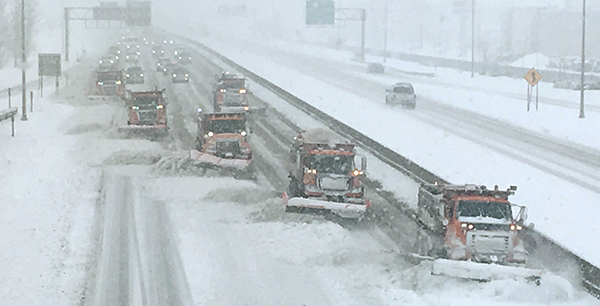
A gang of snowplows muscles through heavy wet snow on Hwy 52 near downtown Rochester on Jan. 22. The Rochester area received about 10 inches of snow from the storm that created blizzard conditions and limited visibility in the southern third of Minnesota. MnDOT issued a number of no-travel advisories throughout the region, and the State Patrol closed the Interstate 35 corridor near Owatonna for a time because of a number of semitrailer crashes. Photo by Anne Meyer |
|
 |
|

|
 |
TABLE of CONTENTS
 |
MnDOT team ready for Super Bowl |
By Sue Roe
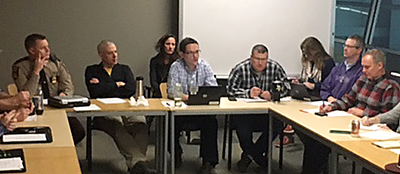
Brian Kary, center, who serves as the agency’s liaison on the Super Bowl’s wayfinding and transportation committees, leads a discussion with other MnDOT employees and State Patrol about different scenarios related to MnDOT’s response to events and incidents during the Super Bowl. Photo by Chris Krueger |
When football fans converge on the Twin Cities Thursday for 10 days of Super Bowl activities, the MnDOT team will be ready.
“MnDOT is a significant player in the Super Bowl. We’re in a strong support role,” said Brian Kary, who serves as the agency’s liaison on the Super Bowl’s wayfinding and transportation committees. “It’s been a great team effort to coordinate it all and we’re well prepared.”
Kary, director of traffic operations at the Regional Transportation Management Center, said MnDOT’s primary role is to manage traffic and keep the roadways clear. MnDOT is working with local transportation partners to plan for the anticipated traffic.
“We’ll monitor congestion but our freeways should be able to handle it. We’re providing key access points to downtown. Interstate 35W will operate as it always operates but the downtown Minneapolis exits will be more difficult,” he said. “A lot of people will come into downtown and MnDOT is ready to respond to that.”
After all, Kary points out, this isn’t the state’s or MnDOT’s “first rodeo” of handling big events.
“U.S. Bank Stadium has a capacity of 66,000 people. In many ways, this is comparable to any home Vikings game and also to the state fair, which draws 200,000 per day,” he said.
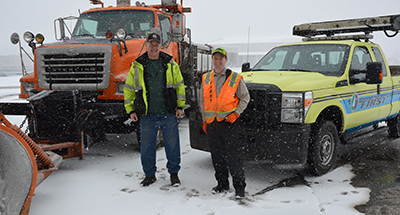
Jay Quam, left, snowplow operator at the Cedar truck station, and Jonathan Sabie, FIRST driver, will be among the maintenance and FIRST drivers on duty during the Super Bowl. Photo by Rich Kemp |
The maintenance office is one of several MnDOT offices working to make sure motorists have safe travel during the Super Bowl activities. If there is a winter storm, maintenance will operate 24 hours. If weather isn’t much of an issue, crews will also be on hand for incident management such as vehicle crashes and protests.
“We’re getting 19 extra trucks from other districts and bringing in our part-time snowplow operators in case of snow and ice,” said Jay Emerson, Metro maintenance superintendent. “Staff will be on duty at five centrally located truck stations on the days prior to the game and on Super Bowl weekend. We’ll concentrate our efforts on the downtown corridor.”
The Multi-Agency Command Center, operated by the city of Minneapolis, will be activated on Friday, Jan. 26, for 10 days. MnDOT traffic management and maintenance staff will rotate duties at the center, along with law enforcement, public works and federal agencies.
Here’s how other MnDOT offices are involved in the Super Bowl:
Office of Freight and Commercial Vehicle Operations – Credentials staff are processing an increased number of applications from limousines and other for-hire passenger carriers to transport people. Safety investigators will assist State Patrol with inspecting vehicles at events and the Minneapolis-St Paul airport. The office informed carriers of their operating requirements ahead of time and streamlined the operating authority application process to make it more efficient. “We are excited to be part of this special event in Minnesota and are working hard to do our part to make this event a success,” said Deb Ledvina, assistant office director.
FIRST Truck – Operating out of the RTMC, eight First Truck drivers will be on duty during Super Bowl Week and six drivers during the weekend of the Super Bowl. Drivers will assist State Patrol and motorists during crashes and when vehicles become disabled on the roadways.
Emergency Management – Staff will support the State Emergency Operations Center in St. Paul to provide nearly 24-hour support and maintain situational awareness from Feb. 1-5. “If any local city or county needs assistance or resources during the event, MnDOT will support as needed,” said Shannon McNulty, MnDOT emergency preparedness manager.
Intelligent Transportation Systems – Mike Fairbanks, signal operations engineer, said MnDOT did a signal retiming to accommodate traffic at Super Bowl Week events near Canterbury Park and Mystic Lake Casino in Shakopee. The retiming was done on County Road 83 near the interchange of Hwy 169. He said new technology was installed at Post Road and Hwy 5 near the MSP airport. “If we see a backup, we can change the timing of the signals for the influx of people coming to and from the airport that week,” Fairbanks said.
Communications – Metro public affairs and Central Office Communications will help staff the Super Bowl Joint Information Center in Minneapolis and work with the RTMC to ensure information about congestion, snow removal and road conditions is shared. CO Communications also gave information on 511 and winter driving safety to the wayfinding committee to provide to visitors, and will be on standby to staff the state JIC if it is activated.
Aeronautics – Staff is working with the Metropolitan Airports Commission and Federal Aviation Administration. About 2,000 private jets are expected to fly in, using every regional airport. Parking for aircraft is limited with some airports shutting down secondary runways for parking. “We aren’t so much involved as impacted,” said Cassandra Isackson, office director. “There will be increased security in and around all the airports. We are pre-arranging spaces to fly in and out of the St. Paul airport.”
Kary said once the Super Bowl is over, MnDOT will turn its attention to another event coming to Minneapolis.
“We’ll have to do this all over again when the NCAA Final Four comes to town in 2019. That one actually concerns me more since it’s two days of games and one of those days is on Monday. We’ll have rush hour traffic to contend with. This has the potential of having a bigger impact on our system,” said Kary.
Marcia Lochner, OFCVO, and Mary McFarland Brooks, Communications, contributed to this story. |
 |
|

|
 |
TABLE of CONTENTS
 |
MnDOT testing autonomous bus at MnROAD, during Super Bowl festivities |
The Minnesota Department of Transportation is testing an autonomous bus at the MnROAD facility near Monticello and during Super Bowl festivities in Minneapolis. This video talks about the bus and testing MnDOT will be conducting. Video produced by Rich Kemp |
|
 |
|

|
 |
TABLE of CONTENTS
 |
District 3 mourns loss of Tina Warwick |

Tina Warwick, employee development specialist in District 3, died Jan. 11. Photo courtesy of District 3 |
Tina Warwick, employee development specialist in District 3, died Jan. 11 after a battle with cancer.
Warwick, 51, started working for MnDOT in 1986 and spent 31 years with the agency. She spent most of her time in human resources and worked in training and employee development since 1998.
“Tina was a very dedicated employee with a passion for excellence,” said Dan Anderson, District 3 engineer. “She will be missed in District 3, especially in our St. Cloud office.”
Warwick is survived by her son, Matthew, and daughter, Madelyn; mother, Patricia Warwick; brother, Lon Warwick; sisters, Tammy Warwick and Angela Ferris. She was preceded in death by her father.
Funeral services were held Jan. 15 at Faith Lutheran Church in Becker. |
 |
|

|
 |
TABLE of CONTENTS
 |
WIG 2.0 efforts help drive recruitment strategies |
|
By Judy Jacobs
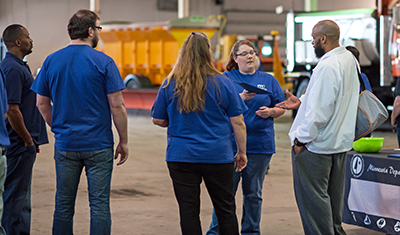
Jeanette Peters, Metro District Human Resources maintenance recruitment, talks to a potential job applicant at a May 2017 job fair held at the Maryland Truck Station. Photo by David Gonzalez |
MnDOT recruiters Kelsey Baumann and Lena Garcia have been on the job for nine months working to build partnerships, create recruitment strategies and build tools to make recruitment part of how the agency does business. A “What Drives You?” campaign was designed to provide a better idea of what working at MnDOT is like to external job seekers.
With the launch of WIG 2.0, many teams throughout the agency started pursuing sub-WIGs related to the goal areas of recruitment and retention to emphasize the focus on Workforce. In hoping to implement proactive strategies for recruitment, Human Resources hired Baumann and Garcia to focus on hard-to-fill positions and attract diverse applicants.
“Lena and I split the agency in half and serve as recruitment account representatives to all of MnDOT’s offices and districts,” said Baumann. “Our goal is to form relationships with all of the offices and districts so they can learn from recruitment and use these discoveries to apply better strategies with each recruitment push.”
The basic process for recruitment is for hiring managers to identify that recruitment efforts are needed. Then, they notify human resources and the recruiters will consult with them one-on-one to determine their needs and establish a solid plan for recruitment. Often, the recruiters will employ online, direct contact and branding assistance to attract strong candidates. Data is built into this process so at the end of the hiring process the recruiters will evaluate where candidates came from and will use this knowledge to form future plans for recruitment.
“We attend events throughout the year, including those hosted by communities, state agencies, industry, and job fairs,” said Garcia. “Our goal with this type of outreach is to create awareness of the types of jobs MnDOT offers and to build strong partnerships that will enable MnDOT to find candidates in the future.”
The MnDOT recruiters have worked to create consistent branding on job postings, advertisements and external outreach. MnDOT recognizes employees are the best recruiters for the agency.
To have a stronger online presence, the recruiters have teamed with Kristi Loobeek, social media coordinator, to refresh MnDOT’s Jobs website. This effort further helps HR pursue recruitment goals and supports WIG efforts around Advancing Equity.
“Partnering with HR to increase MnDOT’s presence on LinkedIn was a natural and welcomed initiative. What better way to promote MnDOT’s open positions than on a platform designed for career networking?” said Loobeek. “If you have not already, follow MnDOT’s LinkedIn company page to share our openings with your own professional network.”
Recruiters make it their goal to provide personal outreach to candidates with hard-to-find skillsets and ensure that they are comfortable with MnDOT’s application process and stay engaged with the types of positions that exist. The recruiters are also available to employees to answer any questions about the hiring process, as well as provide consultation on job opportunities that might be a good fit.
“We believe that this personal touch is something that will help differentiate MnDOT as an employer of choice,” said Baumann. “We also believe that it is a great way to ensure employees remain engaged in the process and know about job opportunities at MnDOT.”
“While these services cover the recurring day-to-day aspects of recruitment, the best part about these positions is they are there to help champion individualized recruitment efforts,” said Garcia. “We partner with WIG teams on their recruitment and retention goals and have championed various efforts that have been requested by offices to aid in their efforts.”
“This partnership is a big part of what makes these positions exciting because they allow you to always have a partner in HR if your ultimate goal is recruitment and retention,” Baumann said. “This is one key way the agency has committed to making recruitment and retention part of the way we do business.”
If you have any questions, need more information or would like to share your ideas, contact Kelsey Baumann at kelsey.baumann@state.mn.us or Lena Garcia at Lena.garcia@state.mn.us. |
 |
|

|
 |
TABLE of CONTENTS
 |
Office of Transit and Active Transportation reorganizes |
By Sue Roe
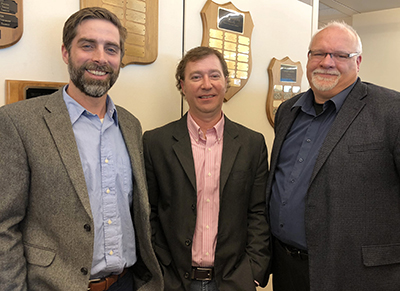
Leading the reorganized Office of Transit and Active Transportation are, from left, Tim Sexton, acting office director; Tim Mitchell, director of planning and programs, and Tom Gottfried, director of implementation and finance. Photo by Sue Roe |
The Office of Transit is now the Office of Transit and Active Transportation. The new name, and office reorganization, reflect the office’s goal to better prepare the Greater Minnesota transit system and MnDOT for the changing needs of transportation in the future.
“The world of transit is changing. We’re seeing transit system consolidation, more opportunities to leverage data and technology and a broader focus on mobility solutions that include walking, biking and transit,” said Tim Sexton, who is serving as the office director on a six-month mobility. “The new structure will better position us for the future while also helping us more efficiently deliver existing services to transit providers in Greater Minnesota and statewide people who walk and bike. The overall goal is to help MnDOT become an even stronger multimodal agency.”
The office reorganization will help align the functions within two sections. The new structure combines planning and programming units into one office section, and budgeting, transit grant management and implementation units into the second office section.
Planning and programming falls under the direction of Tim Mitchell. Implementation and finance falls under the direction of Tom Gottfried.
Within those two sections are six units, including the new Data Management and Innovation unit, which will help the office better use data to inform decision-making and find and incorporate new innovations to promote mobility solutions.
“During our process to take a look at the office, we heard from staff that we need to prepare and deal with data for the future,” Mitchell said. “It’s helping us realize some efficiencies in how we collect and report data. This will give us opportunities to use data to tell our story to the public.”
Early last year, staff began working on the reorganization with Ben Lowndes, Office of Public Engagement and Constituent Services. A staff-led advisory group reviewed ways the office could be restructured from ideas in an office survey and staff meetings. The group provided specific recommendations to office management.
“The process provided opportunities for everyone to participate, share ideas and concerns and to look at the office with fresh eyes,” said Lowndes. “We started with goals for the future and then discussed what the office could look like. It ultimately led to a result that everyone can feel good about.”
The reorganization became official Jan. 10. Sexton said staff is working on an office work plan to clarify roles and responsibilities for each person, units and sections under the new structure. The office will reach out to its internal and external customers in early February when the plan is complete.
Others who will serve in the mobility program office director role are Tori Nill, who is currently on mobility as the District 4 engineer, and Mark Nelson, who is the program director for State Planning.. Nill will start in March and Nelson in September 2018.
“The goal of this mobility program is to expose employees to a multimodal transportation option that enables MnDOT to meet its mission and vision, and influence MnDOT’s collective values, beliefs and practices to be inclusive of modal transportation options,” said Tim Henkel, assistant commissioner for modal planning and program development. |
 |
|

|
 |
TABLE of CONTENTS
 |
Violent Incident Awareness Team takes on new focus |
By Sue Roe
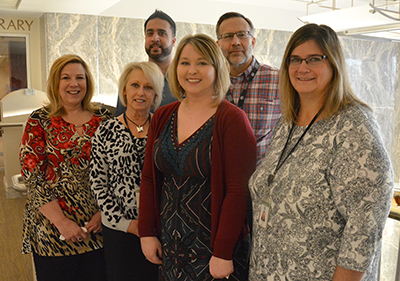
Members of the Violent Incident Awareness Team include, front row, from left, Karin van Dyck, Jodi Mathiason, Rachael Youker and Mary Stohr; back row, Sulmaan Khan and Todd Haglin. Not shown are Patty Eckdahl, Cindy Gross and co-champions Sue Mulvihill and Jody Martinson. Photo by Sue Roe |
MnDOT’s Violent Incident Advisory Team has been around for more than 20 years, but the agency is changing the focus of the team from prevention and management of violence in the workplace to awareness and education. The team is now the Violent Incident Awareness Team.
“It is important for all of us to increase our awareness and understanding of workplace violence,” said Jody Martinson, assistant commissioner in the operations division and co-champion with Deputy Commissioner Sue Mulvihll. “This information is important in our workplace as well as anywhere we are.”
Sulmaan Khan, team leader and senior engineer in the Metro South Area Program Delivery, said the previous team focused on reviewing reports of incidents in the workplace and providing appropriate response and resources.
“The new focus will allow MnDOT to be more proactive in helping curb workplace violence,” he said.
The team informally organized in 1996 during a time when national incidents of homicide, verbal and physical threats, stalking and domestic disputes occurred in the workplace at unprecedented rates. The Minnesota Legislature passed a law mandating all state agencies to adopt violence prevention policies and strategies.
“The next chapter in this is to provide training and education to our employees so these kinds of incidents don’t happen. The more we make people aware, the safer the workplace we will have,” Khan said. “Providing resources such as a planned violence symposium and de-escalation training will help employees have more knowledge and be better equipped to deal with incidents.”
There will be two defined sub-groups under the new VIAT structure. The Critical Incident Stress Management team will help trained MnDOT employees facilitate discussions to help employees manage work-related incidents and stress reactions to work-related events. The goals are to reduce the impact of a critical incident on those involved by helping employees return to work as quickly and safely as possible and lessening the long-term negative effects of critical incidents.
Employees interested in serving on the team can learn more about qualifications and find an application online on the VIAT iHUB site.
The second sub-group is the Threat Assessment Team, which will review reports of workplace violence incidents and serve as a resource to supervisors and managers. The TAT will manage cases and provide follow-ups for high-risk employee situations. The team will also develop and recommend policies, practices, guidelines and procedures to assist MnDOT to reduce and respond effectively to violence.
The TAT will include employees from human resources, labor relations and the safety office. A social psychologist from the Employee Assistance Program will be used on an as-needed basis.
While case management has always occurred, it was more informational. The new structure will allow MnDOT to formalize protocols.
Other members of the VIAT team are Jodi Mathiason, Rachael Youker, Karin van Dyck, Patty Eckdahl, Todd Haglin, Mary Stohr and Cindy Gross.
For more information about VIAT go to http://ihub/viat/index.html.
|
 |
|

|
|

|
 |
TABLE of CONTENTS
 |
Employees help reduce email storage space |
By Charles Stech, Office of Chief Counsel
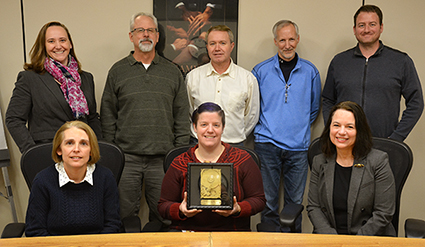
The Office of Environmental Services received the “Golden Hard Drive” Jan. 11 for reducing the most email during this year’s email reduction initiative. In attendance for the presentation were (front row, from left) Lynn Clarkowski, Renee Barnes and Carol Zoff (back row from left) Tina Markeson, Mark Vogel, Harold Bottolfson, Dave Larson and Lucas Bistodeau. Photo by Rich Kemp |
The Office of Environmental Services is the winner of this year’s email reduction initiative. The office reduced its shared drive by 18.04 percent, the highest percentage of reduction for the month of December.
“OES initiated a project to clean up our files on our shared drives and store each with proper, consistent formats,” said Lynn Clarkowski, OES director. “In December, as part of the department-wide clean up month, OES staff was asked to set aside four hours to delete unnecessary emails and calendar items in our outlook to support our continued efforts in data consolidation and management. We will designate four hours twice per year to remain diligent in managing our file storage.”
District 8 reduced the most email for a district at 14.70 percent. Honorable mentions go to the Corporate Services (deleted an average of 4,700 email items per employee), Finance and District 3, all of which reduced their emails by more than 10 percent. As a whole, the agency reduced its email footprint by 5 percent.
“Thank you to all the offices and districts that worked hard to reduce their email storage footprint,” said Jennifer W. Witt, Records and Information manager. “It is a lot of effort and it does help the organization. It is a learning process. We will do the spring clean up earlier next year based on feedback from this event.”
Up next on the clean-up front: “Spring Cleaning” will occur during the entire month of May. MnDOT will delete redundant, obsolete and trivial, or ROT, email. More information will be published in upcoming months. If people have ideas on how to make the spring clean-up a success, email charles.stech@state.mn.us. |
 |
|

|
 |
TABLE of CONTENTS
 |
Public engagement helps improve customer experience |
By Richard Davis, Office of Public Engagement and Constituent Services director
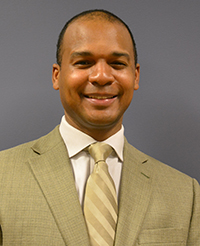
Richard Davis is the Office of Public Engagement and Constituent Services director and the champion of WIG 2.0’s Improve Customer Experience goal. Photo by Rich Kemp |
As recently as two years ago, the MnDOT Ombudsman office and the Customer Relations function operated as two separate and distinct groups. Today, we operate as the Office of Public Engagement and Constituent Services. The PECS office works in partnership with MnDOT’s districts and offices across the state to ensure customers have the opportunity to be heard and to engage with MnDOT. This partnership provides MnDOT staff with the data, resources, training and tools needed to deliver a consistent customer experience.
Part of the rationale for bringing these two groups together was the belief that PECS could help lead MnDOT’s cultural transformation toward becoming a truly customer-centered organization. The timing of the WIG 2.0 kickoff in 2016 has helped PECS and MnDOT expedite this shift within our agency. More people are buying into the idea that MnDOT, and all of state government, must recalibrate its approach to be certain that customers’ needs come first and decisions are made by looking at things from their perspective. In fact, several WIG teams have developed sub-WIGs dedicated to improving the customer experience, either directly for external customers or indirectly for internal customers whose work impacts external partners and end users.
Moreover, today we have more synergy in how we measure, report and monitor the customer experience within MnDOT. The disconnect of information gathering and knowledge sharing between Customer Relations and Ombudsman has been removed. WIG 2.0 brought about the right climate for re-evaluating our work. Today, PECS can create best practices for our district contacts on how to deal with issues, concerns and complaints by making sure our responses are timely, accurate, responsive, understandable and respectful.
There are far too many variables and far too few resources for us to grant every request and agree to the demands made of MnDOT. However, by placing an emphasis on what we can control and creating a consistent customer experience, MnDOT can provide a positive, memorable customer experience. This sentiment is best expressed by poet Maya Angelou … “People will forget what you said, people will forget what you did, but people will never forget how you made them feel.”
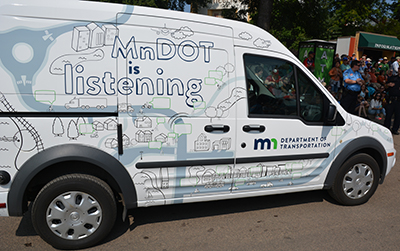
The GoMobile, shown here in the 2017 Minnesota State Fair parade, can be used as an engagement tool to reach the public where they are. The van can be colored using chalk markers, which the PECS office supplies. Employees can reserve the GoMobile online. Photo by Kristi Loobeek |
MnDOT has established an organizational standard that declares customer inquiries should be responded to within three business days. In 2016, the turnaround time agency-wide was approximately 61 percent, with the average overdue response 13 days past due. In 2017 those numbers improved dramatically. We are now at a 73 percent on-time response rate with the average past due reply only four days overdue. More than 3,600 inquiries were recorded last year. This is approximately a 20 percent increase in the on-time response rate, in conjunction with a 30 percent reduction in days overdue. By mitigating any underlying issues related to the customer experience, MnDOT staff can deal directly with the issues being brought to our attention and try to ensure a smooth hand-off between front-line staff and our subject matter experts. On that front, it is encouraging to note that more than 78 percent of survey respondents described the quality of MnDOT’s responses as meeting or exceeding their expectations.
As we move closer to putting WIG 2.0 back into the whirlwind in 2018, we should continue to live out our commitment to a positive customer experience and embrace a way of life at MnDOT where we display “LEADERship” when we interact with our customers:
- Listen and allow empathy to grow organically while working toward a solution
- Empathize by putting yourself in the shoes of a customer
- Ask follow-up questions for context and to determine the underlying interests at issue
- Discuss various alternatives and deliverables, understanding the power of a “positive no”
- Ensure both sides are clear on next steps, to help manage expectations and avoid further disconnect
- Respond as requested and promised to the customer, closing the loop on their concern
From maintenance staff to senior management, public affairs coordinators to policy makers, everyone at MnDOT has a role in making sure the people feel good about interacting with our agency.
Thank you for all you’ve done to move MnDOT forward and for helping us meet our commitment to improving the customer’s experience.
Editor’s note: Davis is also the champion of WIG 2.0’s Improve Customer Experience goal. |
 |
|
| |
|



